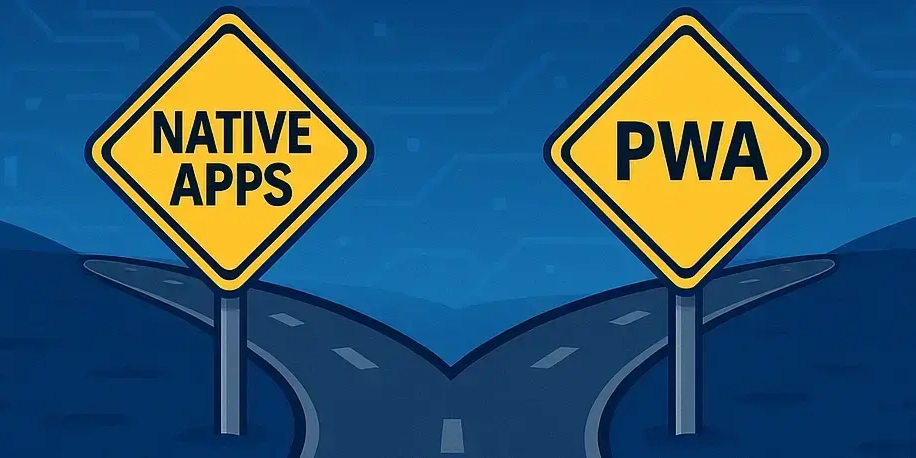Why Native Apps Are No Longer King - Or Are They?
""Just because something doesn't do what you planned it to do doesn't mean it's useless." — Thomas Edison" Imagine: you are young, full of energy and ideas. Or maybe you have a small project, startup, or emerging company. What is your main goal at the start? It’s clear, right? Spend less money, hire fewer developers, launch faster, and reach as many users as possible across all platforms. But if you're a small company or a startup, do you really need to build separate native apps for Android (Kotlin), iOS (Swift), and every other platform? Or is there a smarter way — a tool that lets you build once and still deliver a truly native experience everywhere? Native Apps Today’s market is fragmented across many devices and platforms. Should you really build and support a separate native app for each one? The answer is yes - if you have unlimited resources, a large team of engineers, and plenty of time. Native apps provide: The best performance Full access to platform-specific APIs The highest levels of security and stability However, for most startups and small businesses, these advantages come at a cost that is often too high to justify. Cross-Platform Tools After thinking about this, the next thing we see is: There are now powerful cross-platform tools like: Capacitor Cordova React Native NativeScript These frameworks allow you to write once and run anywhere. Most are web-based, meaning your main stack will be JavaScript/HTML/CSS. You could also explore WebAssembly (Wasm), which supports multiple programming languages compiled to run in the browser. However, UI libraries for Wasm are still limited compared to the rich ecosystem available for JavaScript. Thus, focusing on frontend stacks based on JavaScript remains the most practical and scalable choice today. The Current Situation If you listen carefully, you’ll hear it everywhere: React, React, React. Thanks to React’s popularity, many developers naturally migrate towards React Native for cross-platform development. React Native allows you to target: Android iOS Web and other OSes It sounds ideal - but it’s important to remember: React Native is not exactly React, and it’s not Vanilla JS. You will miss out on many JavaScript UI libraries. So, what if you don’t want to go down the React Native route? The answer is clear: PWA - Progressive Web Applications. But PWAs bring their own set of questions: How well do they work offline? What about local storage and data persistence? How deep is their access to native device APIs? Can you distribute them through app stores like the App Store or Google Play? Let’s dive into these questions. Key Questions for PWAs Offline Mode PWAs use a manifest file to define app metadata and a service worker to cache files for offline use. If you want to store API responses, you have options: localStorage cookies IndexedDB - a powerful, asynchronous database inside the browser Using IndexedDB, you can store large amounts of data locally, enabling a rich offline experience. Native API Access Modern browsers provide access to: Camera Microphone File system Sensors Geolocation Notifications Need even more native features? Frameworks like Capacitor bridge the gap by exposing device APIs to web apps. Installation and Distribution How do users install a PWA? Prompt users automatically within the app ("Install this app" banners) Provide a simple tutorial inside the app interface Use services like PWA Builder to package and submit to app stores (optional) Still, the beauty of PWAs is freedom: You don’t have to go through app stores unless you want to. Browser News for PWAs Here’s some exciting news showing that browsers are actively working on PWA support: March 27, 2025: Safari officially added Web Push support, making push notifications for PWAs more energy-efficient and native-like. March 17, 2025: A hidden PWA support flag (browser.taskbarTabs.enabled) appeared in Firefox Nightly builds (about:config). This shows that Firefox is actively working on full PWA support — big news for the open web community! Conclusion "The best way to predict the future is to create it." - Peter Drucker With Progressive Web Applications, you can: Reach almost every platform Deliver native-like experiences Work offline Maintain just one codebase For startups and small businesses, PWAs are becoming the obvious choice for fast, cost-effective development without sacrificing user experience. Sounds like a perfect starting point for launching your next startup or project, doesn’t it?

""Just because something doesn't do what you planned it to do doesn't mean it's useless." — Thomas Edison"
Imagine: you are young, full of energy and ideas.
Or maybe you have a small project, startup, or emerging company.
What is your main goal at the start?
It’s clear, right?
Spend less money, hire fewer developers, launch faster, and reach as many users as possible across all platforms.
But if you're a small company or a startup, do you really need to build separate native apps for Android (Kotlin), iOS (Swift), and every other platform?
Or is there a smarter way — a tool that lets you build once and still deliver a truly native experience everywhere?
Native Apps
Today’s market is fragmented across many devices and platforms.
Should you really build and support a separate native app for each one?
The answer is yes - if you have unlimited resources, a large team of engineers, and plenty of time.
Native apps provide:
- The best performance
- Full access to platform-specific APIs
- The highest levels of security and stability
However, for most startups and small businesses, these advantages come at a cost that is often too high to justify.
Cross-Platform Tools
After thinking about this, the next thing we see is:
There are now powerful cross-platform tools like:
- Capacitor
- Cordova
- React Native
- NativeScript
These frameworks allow you to write once and run anywhere.
Most are web-based, meaning your main stack will be JavaScript/HTML/CSS.
You could also explore WebAssembly (Wasm), which supports multiple programming languages compiled to run in the browser.
However, UI libraries for Wasm are still limited compared to the rich ecosystem available for JavaScript.
Thus, focusing on frontend stacks based on JavaScript remains the most practical and scalable choice today.
The Current Situation
If you listen carefully, you’ll hear it everywhere:
React, React, React.
Thanks to React’s popularity, many developers naturally migrate towards React Native for cross-platform development.
React Native allows you to target:
- Android
- iOS
- Web
- and other OSes
It sounds ideal - but it’s important to remember:
React Native is not exactly React, and it’s not Vanilla JS.
You will miss out on many JavaScript UI libraries.
So, what if you don’t want to go down the React Native route?
The answer is clear: PWA - Progressive Web Applications.
But PWAs bring their own set of questions:
- How well do they work offline?
- What about local storage and data persistence?
- How deep is their access to native device APIs?
- Can you distribute them through app stores like the App Store or Google Play?
Let’s dive into these questions.
Key Questions for PWAs
Offline Mode
PWAs use a manifest file to define app metadata and a service worker to cache files for offline use.
If you want to store API responses, you have options:
localStoragecookies-
IndexedDB- a powerful, asynchronous database inside the browser
Using IndexedDB, you can store large amounts of data locally, enabling a rich offline experience.
Native API Access
Modern browsers provide access to:
- Camera
- Microphone
- File system
- Sensors
- Geolocation
- Notifications
Need even more native features?
Frameworks like Capacitor bridge the gap by exposing device APIs to web apps.
Installation and Distribution
How do users install a PWA?
- Prompt users automatically within the app ("Install this app" banners)
- Provide a simple tutorial inside the app interface
- Use services like PWA Builder to package and submit to app stores (optional)
Still, the beauty of PWAs is freedom:
You don’t have to go through app stores unless you want to.
Browser News for PWAs
Here’s some exciting news showing that browsers are actively working on PWA support:
March 27, 2025:
Safari officially added Web Push support, making push notifications for PWAs more energy-efficient and native-like.
March 17, 2025:
A hidden PWA support flag (browser.taskbarTabs.enabled) appeared in Firefox Nightly builds (about:config).
This shows that Firefox is actively working on full PWA support — big news for the open web community!
Conclusion
"The best way to predict the future is to create it." - Peter Drucker
With Progressive Web Applications, you can:
- Reach almost every platform
- Deliver native-like experiences
- Work offline
- Maintain just one codebase
For startups and small businesses, PWAs are becoming the obvious choice for fast, cost-effective development without sacrificing user experience.
Sounds like a perfect starting point for launching your next startup or project, doesn’t it?





















































![‘Andor’ Star Varada Sethu on Cinta’s [SPOILER], Her Future With Vel and Killing Tay Kolma: ‘It’s Like Death When She Turns Up’](https://variety.com/wp-content/uploads/2025/05/cinta.jpg?#)


















